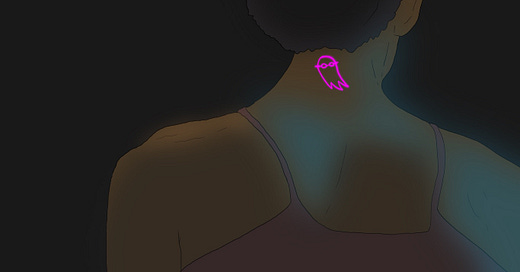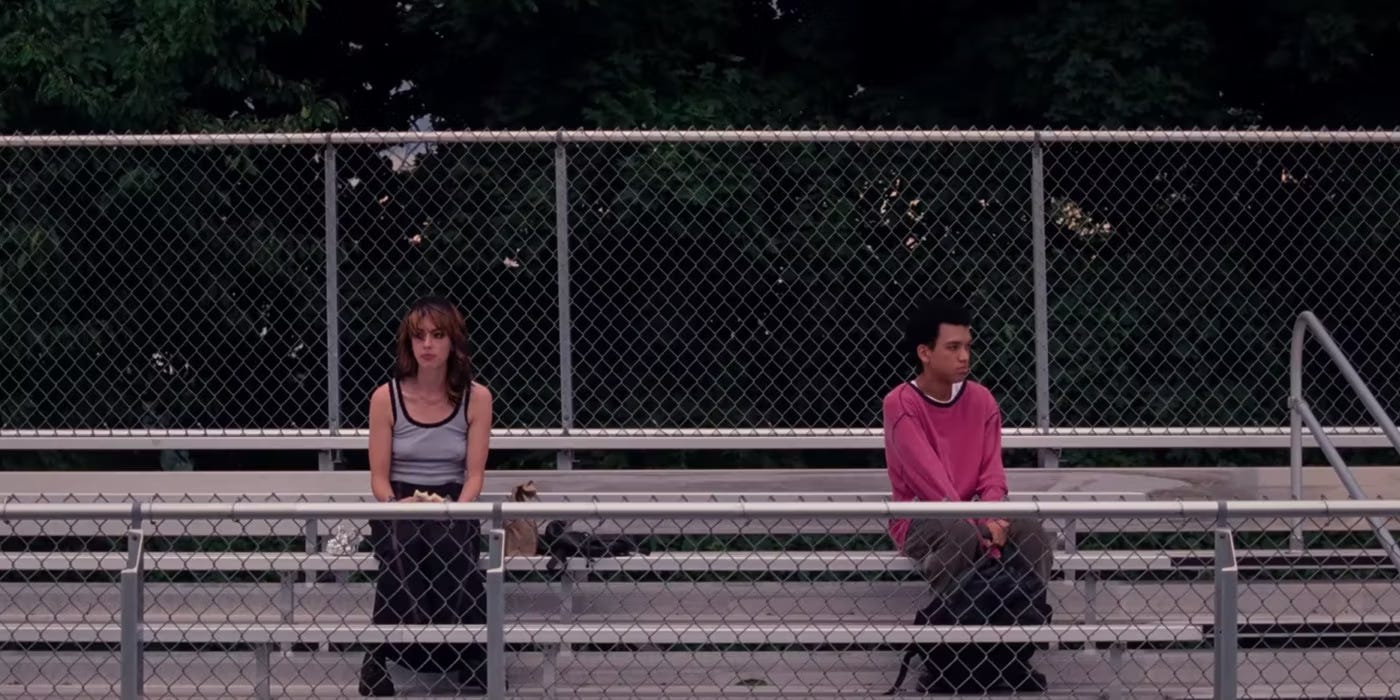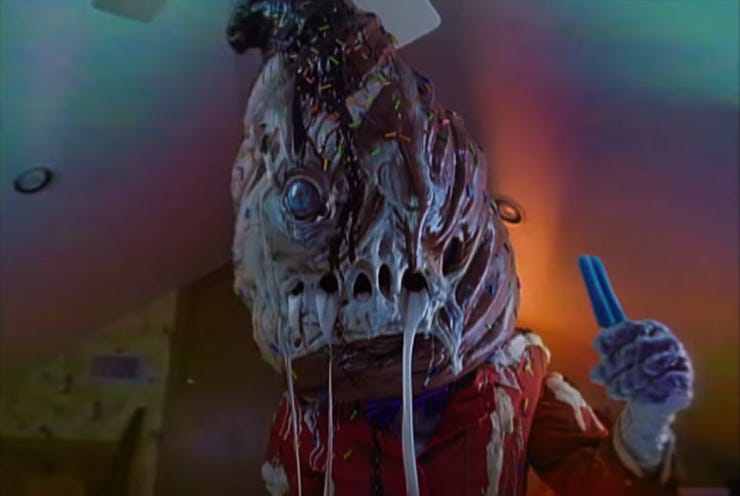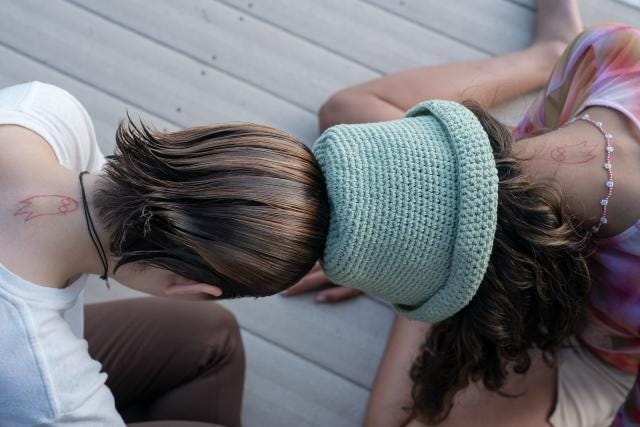Review: There Is Still Time
Jane Schoenbrun’s ‘I Saw The TV Glow’ is beautiful, referential, and horrifying
The Yearning Rating: ✰✰✰✰
Romance: ✰
Sex:
Storytelling: ✰✰✰✰✰
Performance: ✰✰✰✰✰
Yearning: ✰✰✰✰✰
Forward The Yearning to your favorite movie theater companion <3
Minimal spoilers ahead.
Written by Meg Steinfeld-Heim
I knew I would like I Saw The TV Glow. The nostalgia of a suburban childhood—summer nights spent walking in the middle of empty, silent streets, drop offs at the end of your friends’ driveways, the feeling of wet dew and bits of grass sticking to your ankles—rose up from the opening sequence like heat rising from pavement. I settled in to watch as if I were back on the futon in the den of my childhood home, the stack of computer games off to the side of the desktop computer we all shared.
I also felt reassured to learn that Jane Schoenbrun was, like me, clearly a Nickelodeon/Cartoon Network kid—when we see the two main characters tuning in to their favorite show on the Young Adults Network, a little colorful splat sits in the bottom right corner behind the network symbol. This movie made me think about Courage the Cowardly Dog over and over and over again—they’re both grotesque, horrifying, expressive and highly emotional.
I Saw The TV Glow tracks two preteens, Maddy (Brigette Lundy-Paine) and Owen (Justice Smith) who become friends by bonding over a scary yet captivating TV show called The Pink Opaque. The Pink Opaque is about Tara and Isabel, teens that meet at summer camp and become best friends after realizing they share a psychic connection with each other. After summer camp ends, they never see each other again, but work together to fight monsters-of-the-week across the country by communicating on the psychic plane. The Big Bad, Mr. Melancholy, is a grotesque interpretation of the moon that leers at them from the corner of most shots, always threatening to come down and turn the world over into one of darkness and desolation.
Maddy and Owen become friends in that authentically preteen way we all know, which is full of brave lingering and stilted conversation that eventually transforms into genuine connection. Their shared enthusiasm for the show helps them learn to trust each other. Maddy is the kind of adolescent roiling at all times with fury under the surface; she is desperate to get out—out of this suburb, out of this life, and maybe out of this world. “This isn’t how life is supposed to feel. Tell me you know it's true,” she intones, almost catatonic, while lying on the floor. Owen is different; much quieter and emptier, he feels faraway at all times.
I Saw The TV Glow repeatedly brings us into the world of The Pink Opaque by showing us lengthy clips of Tara (played by Snail Mail! aka Lindsey Jordan!) and Isabel (Helena Howard of The Wilds) discovering each other at camp, communicating on the psychic plane, or facing off against the latest monsters. It is a perfect reference to Buffy the Vampire Slayer, down to matching the grainy camera quality and the design of the practical, oozing, scary-but-not-real monsters they face off against. (Also Amber Benson cameos!) The first time you see Isabel’s face, you’re struck by a certain likeness she bears to someone. She looks so familiar.
When Maddy disappears one day without a trace, the story turns to focus on Owen and how he moves through time without his best friend by his side. This is the first time he breaks the fourth wall, turning to address the camera directly and informing the viewers that he never saw Maddy again. This jumped out to me so clearly as a representation of the out of body experience that disassociation can bring. All of a sudden Owen, a character we have only ever been observing, is now telling the story directly to us—almost like he’s not a part of it anymore. I Saw The TV Glow blends Owen experiencing his life with the moments that he steps out of it to narrate to the viewers. It’s a subtly unsettling way to launch into this story of trans identity.
I Saw The TV Glow is visually gorgeous with a haunting aesthetic—it’s equally full of vibrant, sharp colors and shadowy, dark shapes. Grainy old footage plays from VHS tapes and a playground parachute in the colors of the trans flag flutters through a gym class scene. There are perfect homages to the world of 90s practical horror effects and Owen is frequently silhouetted in neon hues of pink or blue, which also seem to be the only two shirt colors he owns. Everything Everywhere All Trans At Once.
Owen’s life marches on through time—something he repeatedly stresses he feels he does not have control over—until one day, Maddy reappears. But she’s different. And she urgently needs to talk to Owen about their past. In a seedy bar where Phoebe Bridgers and Sloppy Jane cameo as the moody live musical guests, she questions Owen on whether or not his memories of their teenhood and time spent watching The Pink Opaque are really as clear and distinct as he thinks they are. Flashes show us a world of different experiences, glowing iterations of the matching pink tattoos Tara and Isabel share in the show appear on the backs of their own necks. But what does it mean? Justice Smith gives a fantastic, heartbreaking performance of someone who is perpetually on the edge of accepting something about themselves; he is afraid, curious, awed, and resistant all at once.
Brigette Lundy-Paine is pure trans magic in this movie—somehow they are able to play both a surly ninth grader with heavy, in-her-face bangs and the same character over 20 years later and post transitioning into something more, all in the span of 100 minutes. As Maddy, they are fearless, never giving up on their quest to find and love every part of Owen—even when he can’t. As they walk through their trans journeys, this message is literally written on the street (in quintessential, suburban sidewalk chalk)—There Is Still Time. There is always time to accept and embrace who you are.
I spoke to a trans friend about the movie, and she had this beautiful perspective to share with me. “Transness is such a personal and painful journey. It’s one you have to work for, and no one can force you to embrace it besides yourself.” I Saw The TV Glow embodies this message and pads it with the additional idea that while it can be uncomfortable, that nagging feeling that something needs to change can ultimately be a beautiful, needed spark for self growth and actualization. Referring to one of the monsters of the week, a character remarks, “Oh, these are kind worms. They disappear if you stop thinking about them”.
Every moment of this movie is thoughtful, intentional allegory, but one thing that really stuck with me in the days after watching was the idea that the duos in the story could continue to communicate with each other, even when not together, via the psychic plane. I found myself comparing this to the way that queer people always seem to find each other. Like how so many of us form close friendships early in life while we’re still deep in the closet. After years and years go by, and we all come out, we have that aha moment—like, of course we were friends! We were all gay! I feel like queerness runs through us all like an electric current. Even when we can’t tap in, it’s still there. How lucky are we.










